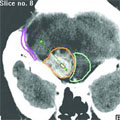The eLitMed.hu medical portal uses computer cookies for convenient operation. Detailed information can be found in the Cookie-policy.
Clinical Neuroscience - 2003;56(09-10)
Content
[Hypothalamic regulation of the food intake]
[The central regulation of the food intake is organized by a long-loop mechanism involving humoral signals and afferent neuronal pathways to the hypothalamus, obligatory processing in hypothalamic neuronal circuits, and descending commands through vagal and spinal neurons to the body. Receptors sensitive to glucose metabolism, body fat reserves, distension of the stomach, as well as neuropeptide and cannabinoid receptors have been identified and localized in the hypothalamus. Five groups of cells in the hypothalamus - arcuate, paraventricular, ventromedial and dorsomedial nuclei, and the dorsolateral hypothalamic area - contain neurons with either anorexic actions (α-MSH, CART peptide, corticotropin-releasing hormone, urocortin III, cholecystokinin, glucagon-like peptides) or that stimulate food intake (neuropeptide Y, agouti-related peptide, orexins, melanin concentrating hormone, galanin). Intrahypothalamic neuronal circuits exist between these peptidergic neurons including the arcuate-paraventricular and arcuate-dorsolateral hypothalamic projections. Circulating substances carrying signals connected to changes in body food homeostasis and energy balance (leptin, ghrelin, insulin, glucose) enter the hypothalamus mainly through the arcuate nucleus. Neurons in the medulla oblongata that express leptin and insulin receptors, as well as neuropeptide mediators project to the hypothalamus. Vica versa, hypothalamic neurons give rise to projections to autonomic centers in the brainstem and the spinal cord with potential for stimulation or inhibition of food intake, energy balance and ingestion behavior.]
[The application of RBANS (Repeatable Battery for the Assessment of Neuropsychological Status) in neurocognitive testing of patients suffering from schizophrenia and dementia]
[Introduction - The purpose of our study was to find out whether the Hungarian adaptation of the RBANS (Repeatable Battery for the Assessment of Neuropsychological Status), a brief neurocognitive screening test, is appropriate for the differentation of healthy and non-healthy subject groups, or for the detection of differences between the cognitive performance of patient groups. Patients and method - The test battery was administrated to 38 healthy subjects, 69 schizophrenic patients, and 18 patients suffering from dementia (10 probable Alzheimer-type and eight vascular dementia). Results - There was a significant decrease of performance in all patient groups compared to the healthy group. In the schizophrenic group, the test indicated a deterioration of functioning in all cognitive areas. The patient group with Alzheimer-type dementia performed only slightly better than the schizophrenic group, because the fall of performance was not significant only one of the cognitive areas (in the visuo-spatial tasks) when compared to the healthy group. There was no difference between the performance of patients with vascular dementia and that of healthy subjects in direct memory, verbal and visuo-spatial tasks. The test results indicated an even deterioration of cognitive areas in patients with Alzheimer-type dementia. As for the vascular dementia group, the most vulnerable area proved to be that of attention, while their verbal functions were relatively spared. The deterioration in other cognitive functions shown by schizophrenic subjects was more moderate, but still significant. A comparison of the RBANS scores of the schizophrenic patients in our study and the result of an American study was also carried out. The global indeces showed no difference; only the pattern of the sub-scales was a little different. Conclusion - The Hungarian version of the RBANS seems appropriate for the differentiation of healthy and deteriorated cognitive performance in a Hungarian patient population.]
[CT- and image fusion guided 125I stereotactic brachytherapy of acoustic neurinoma: three cases]
[Gamma knife and multi leaf collimator Linac have recently gained significant space in the treatment of acustic neurinomas. As our neurosurgical department does not own gamma knife or Linac, we have successfully pursued the 125Iodine interstitial irradiation of three acustic neurinomas. Our patients were elderly people with poor general condition, therefore we decided to undertake interstitial irradiation because of the low tolerance for surgery. The follow-up period until March 2002, lasted five, 23 and 40 months in the three cases. At the end of the follow-up period the audiometrical examination stated slight enhancement of hearing in case one and case two. In case one, the tumor volume, as measured on the control MRI was 5.32 cm3, which meant a 21% shrinkage in contrast to the 6.74 cm3 target volume at the brachytherapy. In case two, the shrinkage was even more apparent. The tumor volume measured on the control MRI examination was 6.64 cm3, which was a 42% shrinkage of the 11.45 cm3 target volume at the moment of brachytherapy. Due to financial reasons, gamma knife and Linac are not available for many countries and neurosurgical institutes. In the absence of the above mentioned radiosurgical methods, we have shown brachytherapy as a new alternative and solution in the treatment of acoustic neurinoma in three patients.]
1.
Clinical Neuroscience
[Headache registry in Szeged: Experiences regarding to migraine patients]2.
Clinical Neuroscience
[The new target population of stroke awareness campaign: Kindergarten students ]3.
Clinical Neuroscience
Is there any difference in mortality rates of atrial fibrillation detected before or after ischemic stroke?4.
Clinical Neuroscience
Factors influencing the level of stigma in Parkinson’s disease in western Turkey5.
Clinical Neuroscience
[The effects of demographic and clinical factors on the severity of poststroke aphasia]1.
2.
3.
4.
5.










